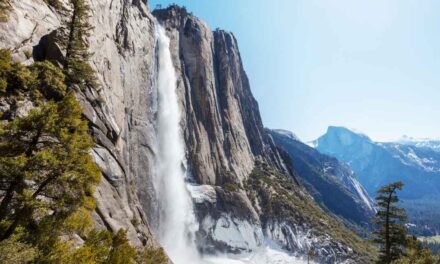Yosemite National Park is world-renowned for its stunning landscapes, featuring towering granite cliffs, powerful waterfalls, and picturesque meadows. But have you ever wondered how these awe-inspiring formations came to be? In this visitor’s guide, we’ll delve into the fascinating geology of Yosemite National Park, highlighting the key geological features and processes that have shaped this extraordinary landscape over millions of years.
Introduction to Yosemite’s Geology
The geology of Yosemite National Park is characterized by its iconic granite formations, a result of the park’s location within the Sierra Nevada Batholith, a large mass of intrusive igneous rock formed from the cooling and solidification of magma beneath the Earth’s surface. Over millions of years, a combination of tectonic, erosional, and glacial processes have sculpted the landscape, giving rise to the breathtaking scenery we see today.
Tectonic Processes: The Formation of the Sierra Nevada Batholith
Subduction and Pluton Formation
Approximately 210 to 80 million years ago, during the Mesozoic Era, the western edge of the North American Plate experienced a series of subduction events, where the oceanic plate was forced beneath the continental plate. As the oceanic plate descended into the Earth’s mantle, it melted, producing magma that rose through the continental crust. This process led to the formation of numerous individual magma bodies, known as plutons, which eventually cooled and solidified to form the granitic rocks that comprise the Sierra Nevada Batholith.
Uplift and Erosion
Beginning around 25 million years ago, the tectonic forces that had driven subduction began to shift, resulting in the uplift of the Sierra Nevada mountain range. This uplift exposed the granitic rocks of the batholith to the surface, where they were subjected to erosion by wind, water, and ice. Over time, these erosional processes removed the overlying layers of sedimentary and metamorphic rock, revealing the stunning granite cliffs and domes that characterize Yosemite’s landscape.
Glacial Processes: Carving Yosemite’s Iconic Valleys
Ice Age Glaciation
The most recent ice age, known as the Pleistocene Epoch, began approximately 2.6 million years ago and lasted until about 11,700 years ago. During this time, the Earth’s climate cooled, and vast ice sheets and glaciers formed, covering much of the planet’s surface. Yosemite National Park experienced several glacial periods during the Pleistocene Epoch, with the most extensive glaciation occurring around one million years ago.
Glacial Erosion
Glaciers are powerful agents of erosion, capable of carving out valleys, cliffs, and other landforms as they slowly move across the landscape. In Yosemite National Park, the movement of glaciers through the region’s river valleys played a significant role in shaping the park’s iconic U-shaped valleys, such as Yosemite Valley and Hetch Hetchy Valley. As glaciers moved through these valleys, they eroded the underlying granite rock, deepening and widening the valleys and creating the steep, sheer cliffs that attract millions of visitors each year.
Glacial Features
When glaciers retreat, they leave behind unique landforms that provide evidence of their presence. Some of these features visible in Yosemite National Park include moraines, glacial polish, and erratics. Moraines are ridges of rock debris deposited by glaciers, marking the boundaries of their extent. Glacial polish occurs when the movement of a glacier smooths the surface of the underlying rock, leaving a shiny, polished appearance. Erratics are large boulders transported by glaciers and deposited in seemingly out-of-place locations as the ice melts.
Erosional Processes: Waterfalls, Meadows, and Rockfalls
Waterfalls
Yosemite National Park is home to numerous spectacular waterfalls, such as Yosemite Falls, Bridalveil Fall, and Vernal Fall. These waterfalls were formed through the combined action of glaciation and fluvial erosion. As glaciers retreated from the valleys, the rivers and streams flowing through them began to erode the exposed granite rock, forming deep, steep-walled channels. In some locations, differential erosion, where harder rock resists erosion more effectively than surrounding softer rock, resulted in the formation of dramatic vertical drops, giving rise to the park’s breathtaking waterfalls.
Meadows
The picturesque meadows found throughout Yosemite National Park are the result of both glacial and fluvial processes. When glaciers retreated from the valleys, they left behind flat, sediment-filled basins. Over time, these basins became filled with water, forming lakes. As sediment continued to accumulate in the lakes, they eventually filled in, creating the lush, flat meadows that provide a striking contrast to the surrounding granite cliffs.
Rockfalls
Rockfalls are a common and ongoing process in Yosemite National Park, as the forces of erosion continue to shape the landscape. Rockfalls occur when large chunks of granite detach from the cliffs and plummet to the valley floor below. While some rockfalls are triggered by events such as earthquakes or heavy precipitation, many are the result of the natural weathering and erosion of the granite rock over time.
Where to See These Geological Features in Yosemite National Park
Yosemite National Park offers numerous opportunities for visitors to witness the geological processes and features described in this guide firsthand. Some must-see locations include:
- Yosemite Valley: Home to iconic landmarks such as El Capitan, Half Dome, and Yosemite Falls, Yosemite Valley is the perfect place to see the results of both tectonic uplift and glacial erosion.
- Glacier Point: This viewpoint offers a panoramic view of Yosemite Valley, Half Dome, and the High Sierra, providing an excellent vantage point for observing the park’s geological features.
- Tuolumne Meadows: Located in the park’s high country, Tuolumne Meadows showcases the glacially-formed meadows and polished granite surfaces that are characteristic of the region.
- Mariposa Grove: This grove of giant sequoias offers an opportunity to see the park’s oldest and largest trees, which thrive in the nutrient-rich soils derived from the weathering of the park’s granitic bedrock.
In conclusion, the geology of Yosemite National Park is as fascinating as it is visually stunning. The park’s dramatic landscape is the result of millions of years of tectonic, erosional, and glacial processes, which have combined to create the breathtaking scenery we see today. As you explore Yosemite National Park, take the time to appreciate the geological forces at work, shaping and reshaping this extraordinary landscape for future generations to enjoy. Whether you’re admiring the towering granite cliffs, gazing at the cascading waterfalls, or strolling through the serene meadows, you’re witnessing a living testament to the power and beauty of our planet’s geological history.


